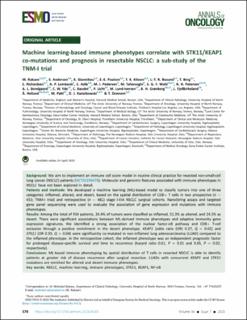| dc.contributor.author | Rakaee, Mehrdad | |
| dc.contributor.author | Andersen, S. | |
| dc.contributor.author | Giannikou, K. | |
| dc.contributor.author | Paulsen, Erna-Elise | |
| dc.contributor.author | Kilvær, Thomas Karsten | |
| dc.contributor.author | Rasmussen Busund, Lill-Tove | |
| dc.contributor.author | Berg, Thomas | |
| dc.contributor.author | Richardsen, Elin | |
| dc.contributor.author | Lombardi, Ana Paola | |
| dc.contributor.author | Adib, E. | |
| dc.contributor.author | Pedersen, Mona Irene | |
| dc.contributor.author | Tafavvoghi, Masoud | |
| dc.contributor.author | Wahl, Sissel Gyrid Freim | |
| dc.contributor.author | Petersen, R.H. | |
| dc.contributor.author | Bondgaard, A.L. | |
| dc.contributor.author | Yde, C.W. | |
| dc.contributor.author | Baudet, C. | |
| dc.contributor.author | Licht, P. | |
| dc.contributor.author | Lund-Iversen, Marius | |
| dc.contributor.author | Grønberg, Bjørn Henning | |
| dc.contributor.author | Fjellbirkeland, Lars | |
| dc.contributor.author | Helland, Åslaug | |
| dc.contributor.author | Pøhl, M. | |
| dc.contributor.author | Kwiatkowski, D.J. | |
| dc.contributor.author | Dønnem, Tom | |
| dc.date.accessioned | 2023-07-18T13:56:04Z | |
| dc.date.available | 2023-07-18T13:56:04Z | |
| dc.date.created | 2023-06-12T09:51:41Z | |
| dc.date.issued | 2023 | |
| dc.identifier.citation | Annals of Oncology. 2023, . | en_US |
| dc.identifier.issn | 0923-7534 | |
| dc.identifier.uri | https://hdl.handle.net/11250/3079720 | |
| dc.description.abstract | Background
We aim to implement an immune cell score model in routine clinical practice for resected non-small-cell lung cancer (NSCLC) patients (NCT03299478
). Molecular and genomic features associated with immune phenotypes in NSCLC have not been explored in detail.
Patients and methods
We developed a machine learning (ML)-based model to classify tumors into one of three categories: inflamed, altered, and desert, based on the spatial distribution of CD8+ T cells in two prospective (n = 453; TNM-I trial) and retrospective (n = 481) stage I-IIIA NSCLC surgical cohorts. NanoString assays and targeted gene panel sequencing were used to evaluate the association of gene expression and mutations with immune phenotypes.
Results
Among the total of 934 patients, 24.4% of tumors were classified as inflamed, 51.3% as altered, and 24.3% as desert. There were significant associations between ML-derived immune phenotypes and adaptive immunity gene expression signatures. We identified a strong association of the nuclear factor-κB pathway and CD8+ T-cell exclusion through a positive enrichment in the desert phenotype. KEAP1 [odds ratio (OR) 0.27, Q = 0.02] and STK11 (OR 0.39, Q = 0.04) were significantly co-mutated in non-inflamed lung adenocarcinoma (LUAD) compared to the inflamed phenotype. In the retrospective cohort, the inflamed phenotype was an independent prognostic factor for prolonged disease-specific survival and time to recurrence (hazard ratio 0.61, P = 0.01 and 0.65, P = 0.02, respectively).
Conclusions
ML-based immune phenotyping by spatial distribution of T cells in resected NSCLC is able to identify patients at greater risk of disease recurrence after surgical resection. LUADs with concurrent KEAP1 and STK11 mutations are enriched for altered and desert immune phenotypes. | en_US |
| dc.language.iso | eng | en_US |
| dc.publisher | Elsevier | en_US |
| dc.rights | Navngivelse 4.0 Internasjonal | * |
| dc.rights.uri | http://creativecommons.org/licenses/by/4.0/deed.no | * |
| dc.title | Machine learning-based immune phenotypes correlate with STK11/KEAP1 co-mutations and prognosis in resectable NSCLC: a sub-study of the TNM-I trial | en_US |
| dc.title.alternative | Machine learning-based immune phenotypes correlate with STK11/KEAP1 co-mutations and prognosis in resectable NSCLC: a sub-study of the TNM-I trial | en_US |
| dc.type | Peer reviewed | en_US |
| dc.type | Journal article | en_US |
| dc.description.version | publishedVersion | en_US |
| dc.source.pagenumber | 0 | en_US |
| dc.source.journal | Annals of Oncology | en_US |
| dc.identifier.doi | 10.1016/j.annonc.2023.04.005 | |
| dc.identifier.cristin | 2153611 | |
| cristin.ispublished | true | |
| cristin.fulltext | original | |
| cristin.qualitycode | 2 | |

